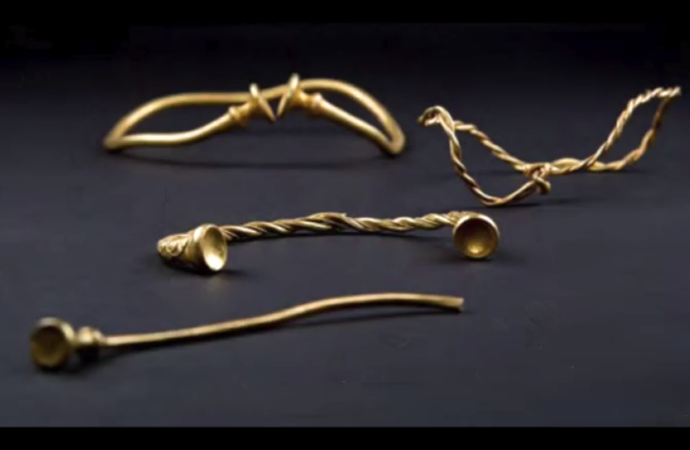Two friends have unearthed jewellery which could be the oldest Iron Age gold discovered in Britain.
Mark Hambleton, who went back to metal detecting after advice from his late father, made the find with Joe Kania, on Staffordshire Moorlands farmland.
The three necklaces and bracelet are believed to be about 2,500 years old.
Their find was declared treasure at an inquest led by coroner Ian Smith, who joked it was likely to be “worth a bob or two”.
Julia Farley, of the British Museum, described the discovery, called the Leekfrith Iron Age Torcs, as a “unique find of international importance”.
Dr Farley, the museum’s curator of British and European Iron Age collections, said: “It dates to around 400-250 BC and is probably the earliest Iron Age gold work ever discovered in Britain.
“The torcs were probably worn by wealthy and powerful women, perhaps people from the Continent who had married into the local community.
“Piecing together how these objects came to be carefully buried in a Staffordshire field will give us an invaluable insight into life in Iron Age Britain.”
Next to bed
The four torcs were found separately, about 1m apart, buried near the surface in Leekfrith last December.
The location is almost 50 miles away from where the £3m Anglo Saxon Staffordshire Hoard was discovered by a metal detector enthusiast in 2009.
The inquest heard the torcs’ gold content was at least 80%, with each piece weighing between 230g (8oz) and 31g (1oz), prompting Mr Smith to say: “Even as scrap, that’s still worth a bob or two.”
A formal valuation will now take place at the British Museum.
To be declared treasure, an item must be more than 300 years old, or have a precious metal content greater than 10%.
“This must rank as one of the most exciting treasure finds I have ever dealt with – not quite in the same league as the Staffordshire Hoard, but nevertheless exciting,” Mr Smith said.
Mr Hambleton said he was just about to give up for the day when his friend said he thought he had found something.
“He pulled this big torc out of his pocket, and dangled it in front of me,” he said.
“When I’d got some air back into my lungs, my head had cleared and my legs had stopped wobbling, I said ‘do you realise what you’ve found there?”‘
He said the pair were “speechless”.
He said he kept the gold next to his bed that night “to make sure it was safe” before handing it to experts the following day.
The jewellery was handed to the Portable Antiquities Scheme, which is administered by Birmingham Museums, but will be displayed at the Potteries Museum and Art Gallery in Stoke for the next three weeks.
The friends said they would share any proceeds with landowner Stuart Heath.
Now confirmed as treasure, the haul is the property of the Crown. The Treasure Valuation Committee will offer a value to the finders, landowner and any museum wanting to acquire it.
Once all parties agree, the museum has to raise the money to pay them.
Source: BBC News

































Leave a Comment
You must be logged in to post a comment.